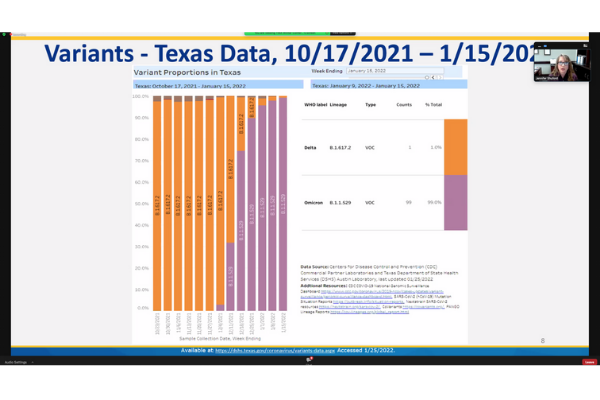
Physicians and public health officials have valuable tools at their disposal to fight the COVID-19 pandemic, such as masking, social distancing, and therapeutics. But the most important tools needed to fight the omicron variant can be summed up in three words: “booster, booster, booster,” John Hellerstedt, MD, commissioner of the Texas Department of State Health Services (DSHS), told the general session of the Texas Medical Association’s 2022 Winter Conference.
“When you compare it to other things that might stem the tide of COVID, the boosters are the one thing that we have plenty of,” he told virtual conference attendees on Jan. 29. “It’s widely distributed and prepositioned throughout the state. It’s readily accessible. And it’s free. And you can’t say that about monoclonal antibodies, or antivirals, or any of that sort of thing.”
The people eligible for boosters already have shown they are open to vaccination, Dr. Hellerstedt said. The chief obstacle to improving the use of boosters remains educating patients, and physicians are well-positioned for that task.
“This is people who’ve had their vaccine, and if I did my math right, there are about 10 million people in the state of Texas who are eligible but have not yet received their booster who I think just need to get the message,” he said.
Dr. Hellerstedt spoke as part of a three-person panel that included Jennifer Shuford, MD, the state’s chief epidemiologist at DSHS; and Donald Murphey, MD, a pediatric infectious disease specialist and a member of TMA’s COVID-19 Task Force. A recording of the discussion is available.
For the entire state, cases of the omicron variant, which have accounted for more than 90% of Texas COVID-19 infections since December, appear to have peaked and are headed downward, Dr. Shuford said.
But she noted the variant’s spread remains uneven across the state. For instance, Dr. Shuford said omicron has peaked in some major metropolitan areas like Houston and Dallas-Fort Worth, but it still is on the upswing in other parts of the state.
Data show booster shots are very important for combating omicron, Dr. Shuford added. In the last 28 days, people without full vaccination – including boosters – were two times more likely to test positive for COVID-19 than people fully vaccinated with boosters. Meanwhile, they are 16 times more likely to die of a COVID-19-associated illness than those who are fully vaccinated.
“New data is showing that the booster is important in protecting against omicron – of getting any symptomatic disease, of going to the emergency department, of being hospitalized,” Dr. Shuford said.
It’s “disappointing” that omicron causes reinfection and breakthrough infections more efficiently than previous COVID-19 variants, Dr. Hellerstedt said.
“Everybody knows someone who was ‘fully vaccinated’ … and even people who’ve been boosted and have nonetheless gotten COVID,” he said. “This has led to a narrative in the public that is false that, ‘Why get a booster because you’re going to get COVID anyway?’ [Because boosters are] the strongest protection from [hospitalization] and death.”
Currently, the Pfizer and Moderna vaccines are recommended as boosters for everyone 18 and older, according to the Centers for Disease Control and Prevention. Only the two-shot Pfizer vaccine is recommended for children aged 5 to17, and booster shots among young people are recommended only for those 12 years old and up.

Many parents question whether vaccinating children is necessary, Dr. Murphey says.
“Do those kids really need vaccine? Do they get sick enough?” he said. “And the answer is, yes, they do. The rates [of illness among unvaccinated children] are much higher than what we see with influenza, which we do routinely recommend vaccine for. There are kids in the [intensive care unit], there are kids who have died of COVID, there are kids who are immune-compromised.”
Pediatricians also see cases of multisystem inflammatory syndrome (MIS-C), which is a group of signs and symptoms linked to COVID-19, Dr. Murphey says. While most children have mild COVID-19 infections, some go on to have major organs – like heart, lungs, and brain – become severely inflamed.
MIS-C can be difficult to diagnose, but Texas probably has had about 1,000 cases of it since the pandemic began. Many of those children ended up in the intensive care unit, when improved vaccination may have prevented these serious illnesses, he says.
DSHS data presented by Dr. Shuford showed that 10.3% of Texans aged 12 to 17 have had booster shots, the lowest among all age groups. About 31% of those 18 to 64 years old and 59.1% of those 65 and older have had boosters.
“We need to be speaking out on the need to immunize kids,” Dr. Murphey said.